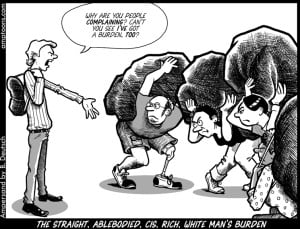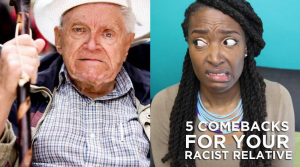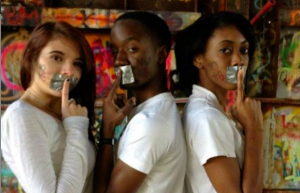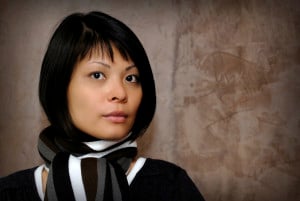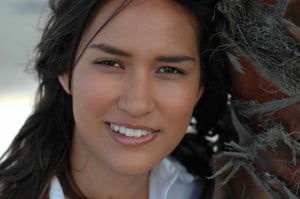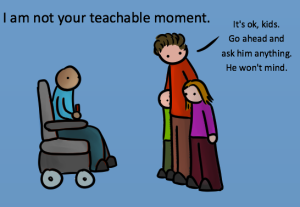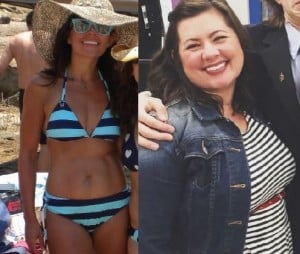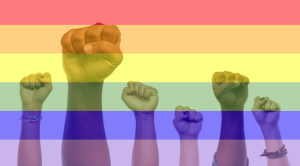Originally published on Femsplain and republished here with the author’s permission.

A person staring straight ahead with a red plaid shirt and bright red lipstick against a black background.
When I hear a greeting that includes the word “lady,” I sometimes cringe. Whether it’s “hey lady” or “good morning, ladies,” it often sparks a little pang in my chest.
Believe me: I realize how dramatic this may sound. After all, it’s a simple greeting — by no means is it intended to hurt or exclude anyone.
And I believe intent is an important thing to keep in mind because it can be the difference between a safe space that could potentially evolve and an unsafe space that refuses to.
Still, gendered terms, however innocuous, can lead to a feeling of exclusion.
It’s not as though I don’t like women or being around them. The majority of my friends are women, most of whom are straight and cisgender, and I love them all dearly.
It’s just that I am not one of them. I identify as non-binary, meaning I do not identify solely as male or female.
I came out relatively recently, so I am still in the early-ish stages of disclosing my identity to people. My presentation is very feminine — I wear lots of makeup, have a lob cut, and don’t bind.
So I understand why most people don’t even think to ask about my pronouns. Only now am I becoming more adamant about speaking up. It’s taken quite a while to feel comfortable even gently correcting people on using they/them/their for me, let alone discuss my feelings toward groups of people I hold so dear.
I recently wrote a piece for Esquire.com answering commonly asked questions I’ve received from strangers and acquaintances since coming out. The article is intended as a primer for those unfamiliar with non-binary genders — a quick and dirty rundown for the uninitiated, or afraid to ask.
It wasn’t necessarily written for any specific group or space, just those who may not surround themselves (at least, knowingly) with people who are non-binary.
The response has been overwhelmingly positive, though there have been plenty of trolls, but that was to be anticipated because (A) this is the Internet and (B) I am not a white dude, which brings me to the point of this piece.
I don’t expect to feel welcome, or even all that safe, on the Internet for (what I assume are) obvious reasons. But female-centric and particularly feminist spaces can feel different because they often thrive on both a receptive and safe environment.
Yet there are so many groups and social circles that insist non-binary folks are welcome that, in reality, use gendered language, generalizations and even the occasional body shaming, all of which can make people, including non-binary people, feel like they don’t belong.
“Real Women Only”
Maysam “Phoenix” Seraji, a transmasculine butch student living in Syracuse, New York put it well with:
“In the past, trans women and trans femme folks are told they are socialized as men or are otherwise not ‘woman enough’ to join feminist and female-centric spaces. Today, there are some movements to expand more towards trans inclusivity, but many TERFs (trans exclusionary radical feminists) are still at large.
There are some instances when trans men/trans masculine people, however, are welcome in those same spaces because they were assigned female at birth, and this is problematic, because trans women/femme people should be allowed in those spaces too.”
These groups often exclusively describe themselves as being intended for women; the postings often begin with “hi girls!” or “hey ladies!” The conversations surround dilemmas that face cisgender women daily. So it can feel anxiety-inducing, however self-imposed that is, to bring up non-binary issues.
I would not discuss, say, the difficulties I have peeing with a prosthetic unless I’m in a queer-centric space. (BTW if anyone has some pointers on that, dear god, shoot ’em over to me.)
It never seems deliberate. But when the majority of a group, whether it’s on Facebook or Slack or a message board, also isn’t deliberate with making diverse and marginalized voices feel heard, it can enforce the idea they shouldn’t speak at all.
“When I say ‘women,’ I just mean ‘not men,’” I have heard people protest when these issues are brought up — and I get that.
It’s easier. It’s simple. But for many of us, neither “women” nor “men” are applicable terms.
And when groups refuse to acknowledge or engage in conversations about marginalization, the setting can start to feel like a bar where non-binary people are allowed to come inside so long as we don’t drink, dance, or socialize in.
We aren’t to question the environment — in fact, it’s as if we’re supposed to feel grateful we were even allowed in the door.
I’m not writing this to call any one group out or to make any single person feel attacked (as majority groups often do when someone questions their behavior) but to encourage declaratively inclusive environments to practice what they preach.
This isn’t exclusive to female-based groups. It’s a pervasive issue in any space that touts inclusiveness and shuns uniformity while enforcing unspoken boundaries members should abide by.
After being excluded from a community for women and non-binary writers for his use of he/him pronouns, non-binary writer Sam Dylan Finch (whose Twitter you should definitely follow) discussed the rejection of non-binary people by cisgender people who dictate these guidelines that members must fall within.
Finch writes, “If you are looking to hold space for ‘non-binary people’ without qualification, that means all non-binary people — even those who are questioning, even those who are fluid, even those who occupy multiple spaces simultaneously.”
If female-founded spaces wish to invite non-binary people into them, by all means do so.
But ask non-binary people for their opinions and actively make inclusiveness a priority, the same as you might for any marginalized group.
Eyes are rolled when men make up the majority of panels on women in tech or politics, but rarely when cisgender, white, straight women run groups about diversity.
Why It’s Necessary
Women as a whole grow up putting up with a lot of bullshit. It would never be my objective to invade a group that was designated for cisgender women — plus, who really wants to be in a group they’re not welcome in? And people should be able to create or find spaces that make them most comfortable.
But be honest with what the space is intended for. If they’re supposed to be exclusive to binary women, be clear on that. But if you want to be inclusive, be inclusive.
Believe me, I understand the need for spaces without cisgender men — and it’s the same reason trans and gender non-conforming people need them. We all have a lot in common, after all.
“Safe spaces need to be inclusive for trans and gender non-conforming individuals because we are higher at risk for things like suicide, homelessness, and murder,” explains Seraji. “When things like trans panic exist as a legal justification for our murder, society is telling us routinely that we don’t deserve to live. We are being denied healthcare, housing, and so on.
It’s important to have safe spaces for us so our voices are heard.”
Trans and non-binary people experience these issues in extremely high numbers, according to the National Transgender Discrimination Survey Report. For people of color, these statistics skyrocket.
Safe communities can go a long way — both to help support transgender and gender non-binary people, and to educate those in the spaces about the challenges that face those who are not cisgender.
Fortunately, many groups are looking to up their inclusivity in a direct and deliberate way.
Allison Esposito, a cisgender woman who runs the #NYCtechladies, told me:
“We have a monthly coffee meet-up and a Facebook group and the mission is just to bring together women in tech in New York City. Many people have found jobs through the group, made strong connections, and found a place to commiserate about being a woman in tech. Now that I’m running this [group], I don’t want to leave anyone out.”
It can be difficult to change one’s habits to make a space more inclusive. The burden of education is often placed on those who do not initially feel included and welcome.
Anecdotally, I know many people of color who feel exasperated at the constant expectation for them to explain privilege and problematic language to white people who often are unwilling to listen, let alone reflect on themselves.
For people who are trans or non-binary, it can get exhausting to clarify the differences between identity, sex and presentation, or to say why certain gendered terms can foster an environment of exclusivity, but when the audience is receptive, it can change everything.
How to Get Serious About Inclusivity
“People need to get informed and check themselves — there are plenty of resources on trans inclusivity online and I’m certain a bit of googling would go a long way,” explains Seraji. “Gender-neutral bathrooms are a little more difficult to come by, but certainly help a space become much safer to trans and non-binary people.”
They recommend using language like “folks” to address people rather than “ladies and gentlemen” and the like, as well as asking for people’s preferred names and pronouns. These simple shifts can make a space more friendly to trans and non-binary members.
Rather than waiting to see how the community evolves on its own, Esposito has taken action to improve her group — a productive step towards inclusivity. She says, “I’ve reached out to people who identify as trans and non-binary to get help with language that feels welcoming and inclusive and I’ve since updated that.”
Personally, knowing that the people around me respect all gender identities is deeply important. The majority of my friends are women and they’re all incredible human beings I want in my life.
When I came out, I didn’t feel the need to leave my social circle in order and restrict myself to spaces that are designated for non-binary people, though many folks find those very rewarding, and that is wonderful.
I simply wish that being in predominantly female spaces didn’t mean pretending I’m a female.
I worry sometimes that many of my friends don’t use “they” and “them” to refer to me when I’m not around. While I realize it’s initially awkward, it’s something that’s deeply important to me and my identity at this point.
It doesn’t bother me quite so much when I imagine strangers misgendering me, though. Same goes for groups I occupy space in — I wouldn’t mind if some stupid message board I’ve never been on repeatedly referred to me as “she,” but feeling erased in a group I care about is much more upsetting.
I don’t love the term “ally,” but the concept of it is an important one to examine in these groups. Being an ally isn’t just not actively participating in oppression and prejudice — it means listening, continuously supporting, educating and questioning oneself.
If someone wants to create a safe space that’s inclusive, they should do so, but in a way that actually acknowledges and welcomes the voices of all those they wish to be present.
Ask people about their pronouns. Ask how to make language more inclusive. Open discussions to queer topics because sometimes, LGBTQ folks need some indication they’re welcome.
When done right, inclusiveness can strengthen a group beyond belief.
[do_widget id=’text-101′]
Sam Escobar is the Beauty Editor of GoodHousekeeping.com. They live in Brooklyn with their two fat cats, Dorito and Rorschach. Follow them on Twitter and Instagram for sheet mask selfies galore.
Search our 3000+ articles!
Read our articles about:
Our online racial justice training
Used by hundreds of universities, non-profits, and businesses.
Click to learn more





